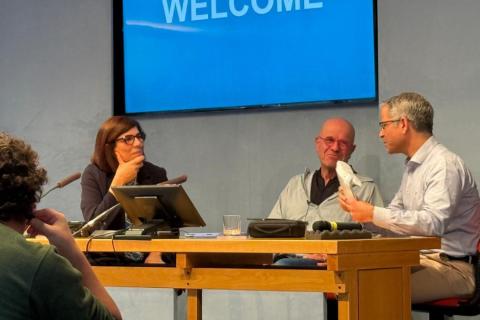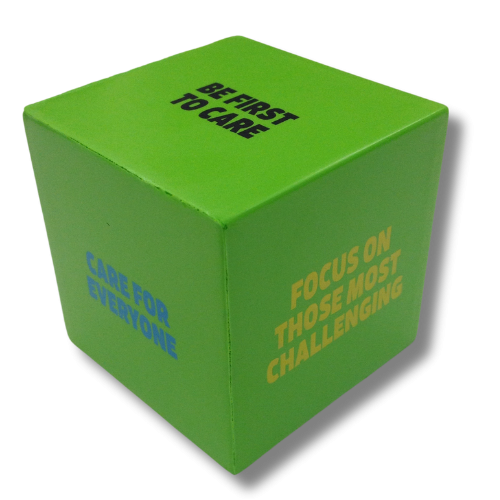
Photo by Maxim Lupascu | Dreamstime.com
When the #DaretoCare campaign was launched some time ago (see unitedworldproject.org/en/daretocare), I felt inspired to roll up my sleeves and get involved by showing hands-on-care to a vulnerable group in our society. I trained as a counsellor for a telephone counselling service for young people.
Since then I have had the privilege to offer a listening presence with unconditional acceptance to many adolescents who are struggling with life’s challenges. Often, in contact with them, I notice that because of their high stress levels, their thoughts have run away with them and pulled them into an abyss of overwhelming despair.
A good way to support these young people is by inviting them to come back to the present moment. I do that with a technique that brings awareness to what they experience right here and right now through their senses.
I ask the young people to get into a comfortable position, put their feet on the floor, and breathe slowly in and out. I invite them to focus their attention on their sensations in the present moment.
I ask them to notice and talk to me about five things in their surroundings that they can see. When they’ve done that, I invite them to focus their awareness on four things they can touch, three things they can hear, two things they can smell and one thing they can taste.
It always surprises me how helpful this technique is to calm someone’s overreactive nervous system and open up a space for reflecting and a new field of choice.
Many young people have told me that they also use this technique when they are by themselves and are finding it useful in their daily lives. This technique is basically a practical way of getting away from ruminating about past events or worrying about future events and anchoring oneself in the here and now.
Calming our “jumping-bean” minds
Most world religions, spiritualties and non-religious wisdom teachings would agree that being in “the present moment” is key to resilience, personal well-being and wholesome relationships.
And yet, remaining in the present moment is one of the hardest things to do. Our mind constantly travels between past and future events. Some people talk about humans having a “jumping bean mind,” flitting from one thought to the next.
The good news is that we can practice being in the present moment. Learning to remain there as much as possible is, however, not only a cognitive decision. It can be very much supported, as in the example above, by using our senses.
Harnessing the vagus nerve
Let’s explore another strategy that I personally find very helpful. It is what I call, using our internal “superpower”: the vagus nerve.
The vagus nerve is also called the 10th cranial nerve. It departs from the bottom of our brain, the brain stem, and touches all major organs of our body. It activates the parasympathetic nervous system, which is that part of the nervous system that has a calming influence on our mind and body. It slows our heart rate, relaxes our muscles, makes us rest and digest.
Normally, this happens automatically, but the great thing is that we can actively use the vagus nerve to calm ourselves. One of the best ways to do this is by breathing slowly, deeply and rhythmically. This is also called deep diaphragmatic breathing.
Deep diaphragmatic breathing is a slow inhale, followed by a slightly longer, slow exhale—while using our diaphragm, the dome-shaped muscle just below the lungs. Because the use of the diaphragm can be seen when our belly moves in and out, it is also sometimes called “belly-breathing.”
This type of breathing has always been known in meditation and contemplation as part of a calm and regulated state. Recently it has been researched also from a neurophysiological point of view.
It was found that by increasing the length of our exhale after taking a slow deep inhale, the vagus nerve is triggered to secrete a transmitter substance called acetylcholine, which has a calming effect on our physiology.
We don’t have to engage with complicated breathing exercises. It is enough to simply slow our breathing for a few in-breaths and out-breaths and focus on using our diaphragm for belly breathing. A slightly longer out-breath than in-breath is recommended.
In this way we allow our body to still our mind. We can engage with this type of breathing as many times throughout the day as we want, using it as an anchor that makes us experience in body, mind and soul that our life happens here and now.
Binding us to the present moment
I would like to conclude with a reflection by Chiara Lubich, published by New City in the book Here and Now.
“What counts for us Christians is not how much we do, but how we do it. The historical Jesus did not change the world either. On the contrary, sometimes he seemed to fail. What matters is to fulfil the plan God has for us—no more, but also no less.
“Wherever we are, let us work at adoring his will, which binds us to the present moment. This helps us to take care, one detail at a time of what we need to achieve in the world.”
First published in New City, London












